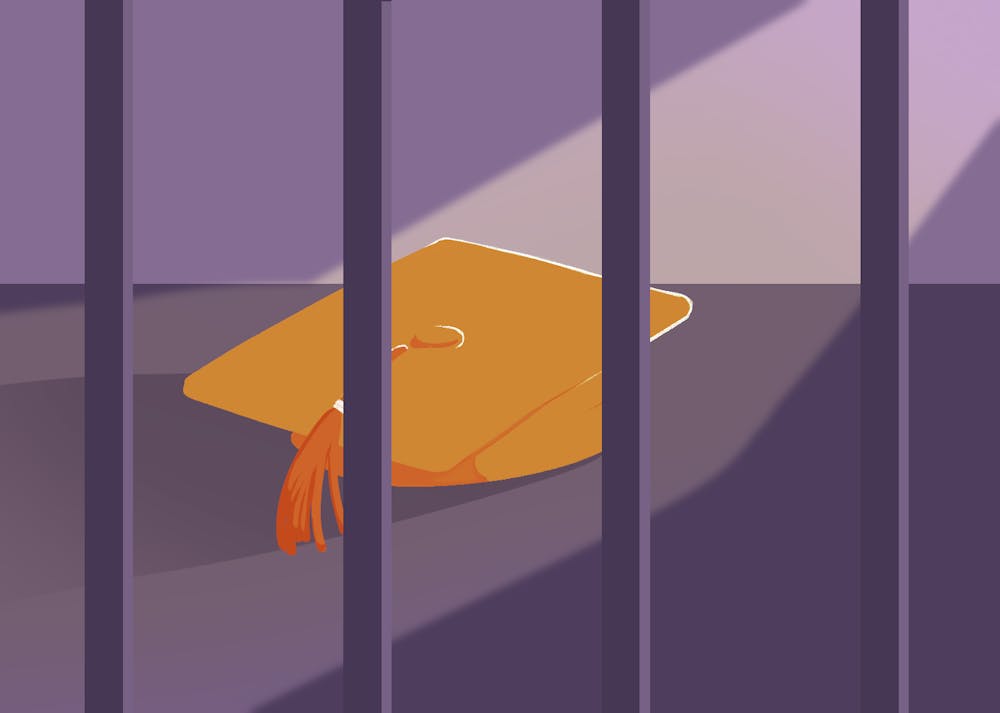ASU's Inside-Out Exchange Program arose from a need to humanize the education system, according to program director Kevin Wright.
The program places incarcerated students and ASU undergraduate students together in a classroom setting with the goal of creating an actionable project designed to improve the correctional system.
"It's about focusing on what makes us human, whether we're incarcerated or not," Wright said.
The course is a partnership between The School of Criminology and Criminal Justice and the Arizona Department of Corrections, Rehabilitation & Reentry, but the program originally started in 1997 at Temple University by Lori Pompa. Since then, the now-international program has extended to 48 states and 12 countries, with upwards of 60,000 participating students, Wright said.
The class features an equal number of ASU students and incarcerated students from an Arizona State Prison Complex facility. Though the incarcerated students aren't actively enrolled at ASU while in the program, upon their release, they can apply to the University and the credit earned will be honored.
Wright, associate professor at the School of Criminology and Criminal Justice and director of the Center for Correctional Solutions, brought Inside-Out to Arizona through the Center for Correctional Solutions in 2016.
The course, titled "Motivational Justice," centers around principles of motivation, driving forces and purpose, within the lives of incarcerated and non-incarcerated students. The main component is mindfulness.
"It's a curriculum that says by embracing the elements that make us all humans — things like the desire to have autonomy and mastery of purpose and meaning in our lives — we can approach the way that we view the justice system," said Alexis Klemm, a graduate student in criminology and criminal justice and facilitator for the Center for Correctional Solutions.
The curriculum is non-traditional in that it is not lecture-based, instead focusing on discussion and interactive activities. The model was something Wright had seen within education specialized for incarcerated settings.
The motivation for involving ASU in a program like this was reinvigorating the humanity and stories he'd seen in correctional facilities and moving away from "the flat lecture or PowerPoint style," Wright said. "We can do better than this on the student side."
Though most lessons involve interaction among students, some lessons encourage introspection like bringing students back to their childhood by introducing a coloring exercise.
"There aren't a whole lot of opportunities to be mindful versus mindless in prison, but these small kind of childish ways are a way that we may be able to do that," Klemm said.
The class also works together to complete a puzzle, where everyone has a certain number of pieces. At the end of the exercise, the incarcerated students reported that "for the first time, they had forgotten they were in prison," a place where close proximity is not a comfortable thing, according to Klemm.
Klemm aids Wright in facilitating the program. She was a member of the class in Fall 2019, held at the women's prison in Arizona.
The class experience changed her career trajectory from FBI investigator to Inside-Out facilitator. She has been in correction spaces ever since.
"It's a really unique perspective. For me personally, it was my first introduction to tangible, real ways that we could be looking at the justice system and changing the justice system rather than just broadly addressing what's wrong with it," Klemm said.
The Center for Correctional Solutions has other initiatives, among them, an incarcerated student art program called Art from the Inside, which offers an outlet for incarcerated individuals to sell their art to the general public.
It grew from the "Inkarcerated: Creativity Within Confinement" program at the Unexpected Gallery in May 2017, where all proceeds went to youth and family charities.
Bruce Ward, co-curator of the Inkarcerated Art Show and fellow at the Center of Correctional Solutions, was incarcerated from 2009-2020. He participated in the Inside-Out Exchange Program at the Florence North Unit and the Inkarcerated Art Program.
Ward, an ASU undergraduate student who studies sculpture, embraces mindfulness and the reduction of recidivism along the same lines of the Inside-Out Program.
"One of the reasons I have credibility as a mentor on how to adapt to this society is because I failed once," Ward said.
As a former marine, Ward likened reintegration into civilian society after the military to reintegration after incarceration.
"The time to form a new identity is now while you're incarcerated, not the day you get out," Ward said.
According to Ward, the secret is finding purpose before you're out. He said if he'd had access to a community-based program like Inside-Out or Inkarcerated after the military, he may not have become a criminal statistic.
While incarcerated, he found his purpose mentoring other artists within the cellblock. Drawing became a process of self-improvement for himself.
"I was reflecting and introspecting for the first time," Ward said. "Having those opportunities, those chance meetings with ASU, and getting the education from them. … When I got out, nine days later, I was at ASU studying sculpture."
The Inside Out Exchange Program, the Inkarcerated Art Show and other programs under the umbrella of the Center for Correctional Solutions have the similar goal of establishing a connection between incarcerated individuals and students.
When Wright began the program, he thought it would benefit ASU students to see the humanity in incarcerated individuals as they prepare for roles in law enforcement.
What he didn't realize was that the growth would go two ways. The incarcerated individuals, many of whom had some hardened and pre-conceived notions of the criminal justice system, also saw the humanity in the ASU students who were studying to be lawyers and law-enforcement officers.
"We sometimes see a shift or a change of perceptions in the criminal justice system based on showing the humanity of our ASU students," Wright said.
Edited by Sadie Buggle, Piper Hansen and Anusha Natarajan.
Reach the reporter at kbartune@asu.edu and follow @BartunekKaren on Twitter.
Like The State Press on Facebook and follow @statepress on Twitter.




